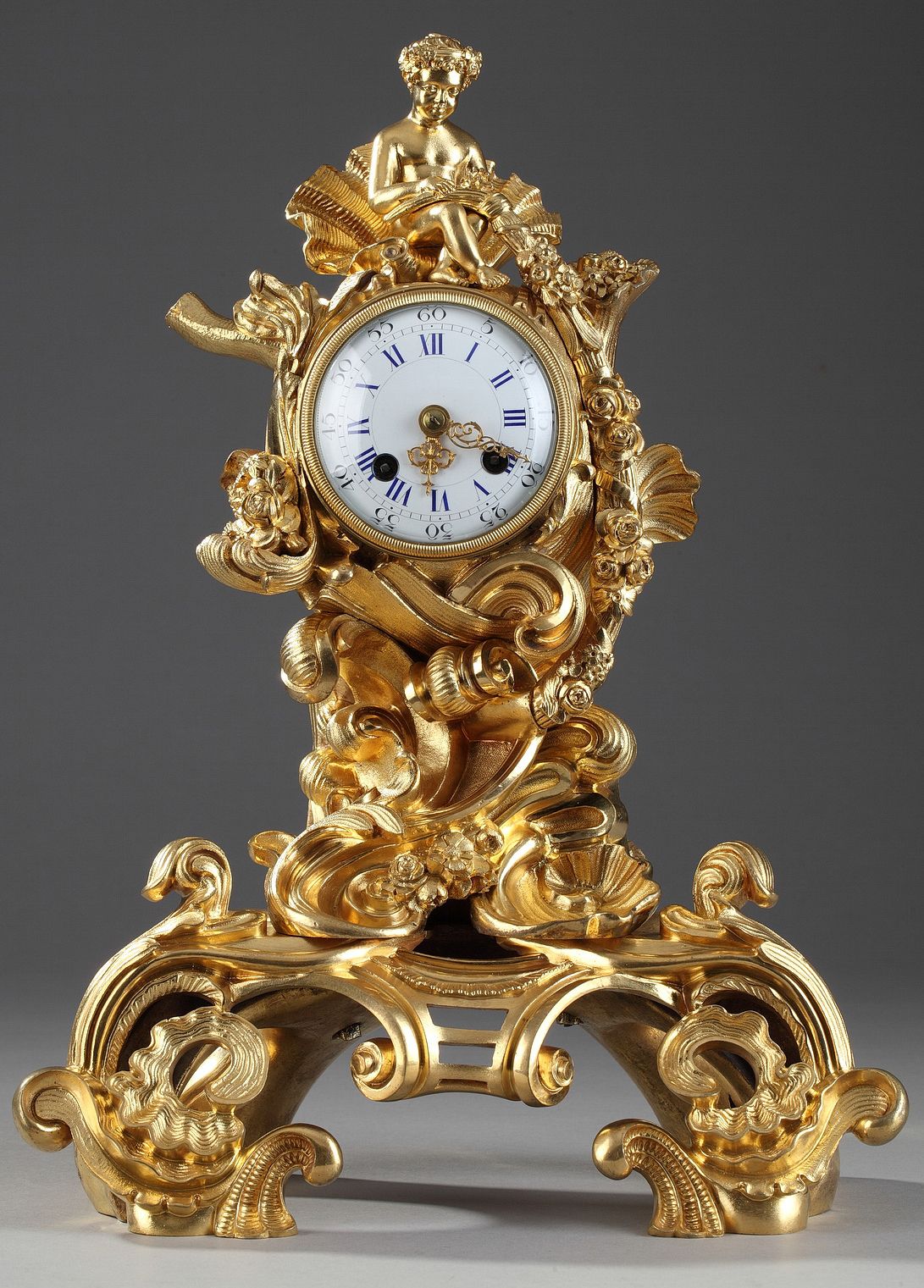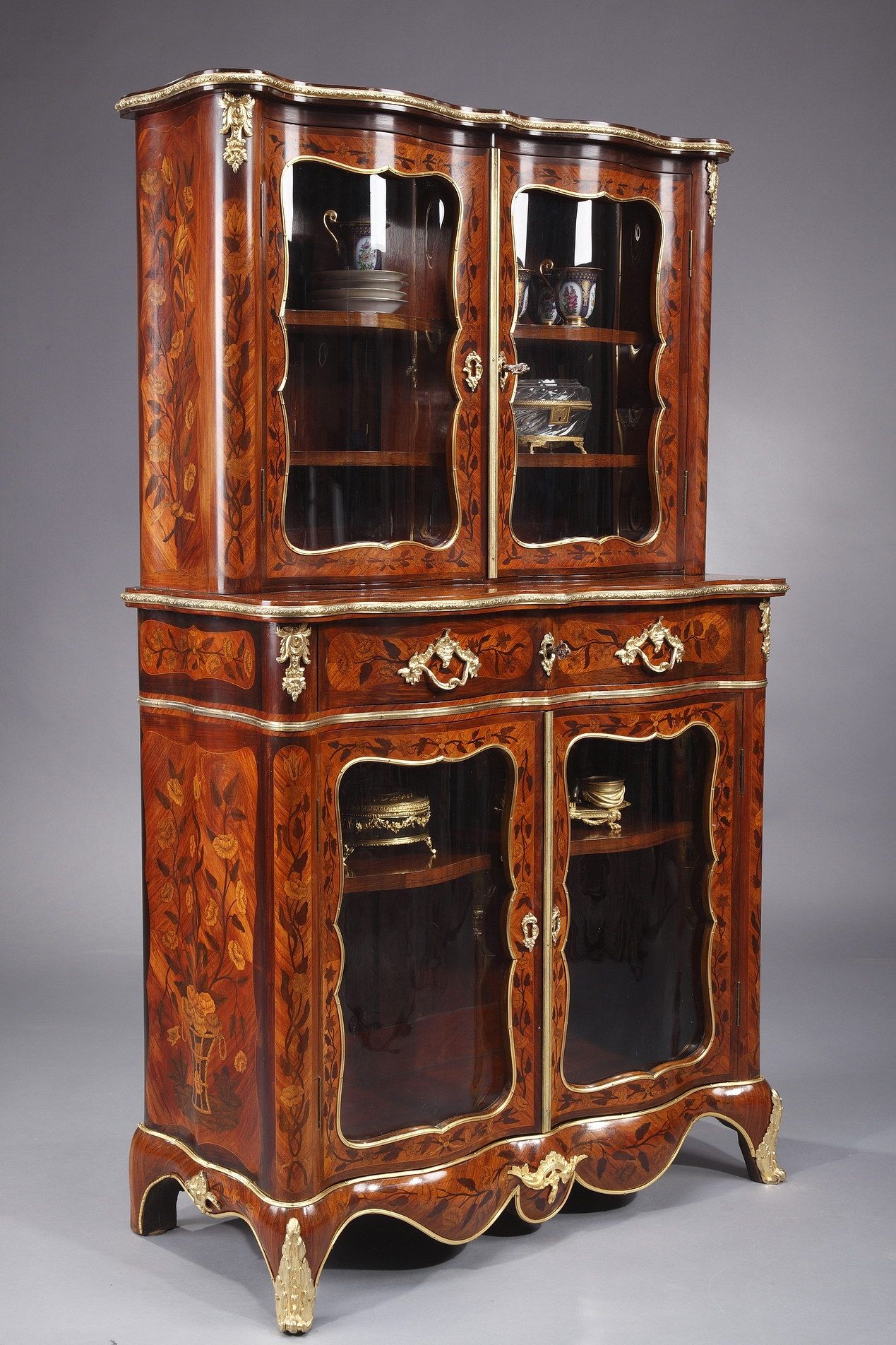The peaceful and prosperous reign of Louis XV (1715-1774) allowed for a prodigious development of the arts, humanities and sciences. The construction of new palaces and the blooming of painting and sculpture gave rise to a new art of living in which the talent of craftsmen and cabinet makers was expressed. This was the golden age of French decorative arts.
 Gilded fireplace mantel Clock in the Louis XV style bronze
Gilded fireplace mantel Clock in the Louis XV style bronze
For the elegance and refinement of its curves, the brilliance of its marquetry and its wealth of invention, the Louis XV style is, in the eyes of the world, the most representative of French taste. It developed mainly in the second quarter of the 18th century (from 1730 to around 1760). More commonly known as the Rococo style or Rocaille style, its decorative repertoire was inspired by shell shapes, Italian Baroque and Far Eastern art.
The furniture
The Louis XV style is without doubt the greatest period of French furniture. The materials were very varied and the techniques remarkable. The forms multiplied and adapted to all needs: furniture became easy to handle and practical without ceasing to be elegant.
 Louis XV style marquetry display case, 19th century
Louis XV style marquetry display case, 19th century
Under Louis XV, shapes varied endlessly. To satisfy distinguished occupations and elegant leisure activities, all sorts of small pieces of furniture were invented for specific purposes: craft, coffee or tea tables, dressing tables and powder cases. Consoles, seats, sofas in oak, walnut or poplar are countless in their diversity.
Variety of materials is combined with multiplicity of forms. The evolution of furniture in the Louis XV style is characterized by crossbow contours, bellied and curved shapes. Alongside gilded wood used for consoles, overmantels and ceremonial seats, marquetry of variously colored woods appears, followed by various varnishes, imitations of oriental lacquers.
Bronzes are very present in interior decoration, such as arms of light, candelabras and the many ornaments applied to furniture. Designed to decorate and protect furniture, these are gilded with ground gold, but more often than not they are varnished in gold colour. In addition to the gilded bronzes, marble tops were added to follow the sinuous shape of the fronts and give the furniture sumptuous touches of colour.
Ornamentation
 Pair of ormolu candelabra in the Louis XV style
Pair of ormolu candelabra in the Louis XV style
Under Louis XV, it is highly recognizable for its fantastic movement and gushing life, in contrast to the stiffness of the previous century. It is characterized by the use of curved lines and rocaille, and a pronounced taste for non-symmetrical plant motifs and exotic themes.
Curved, flowing lines are used systematically to soften shapes and motifs. But sinuosity does not exclude a certain firmness: C- or S-shaped lines arch nervously or bend gracefully.
Rocaille is the most striking expression of the Louis XV style. The name was first given to a bronze or earthenware rock forming the base of an object, then the term was extended to all tormented production to define a whole way of feeling and seeing.
Exoticism was ubiquitous in the mid-18th century: first, imports from the Far East were copied, then fanciful decorations featuring Chinese figures, exotic birds and pagodas.
The decorative motifs are common to bronzes, silverware, wood carvings and marquetry. Their themes are borrowed from flora and fauna. The cartouches are curved, inclined and framed by rocaille motifs. The shell, very much in use, is irregular and is torn apart: it is serrated, openwork or pleated. The flowers are stylised: in bouquets or in garlands, the flowers are present everywhere, surrounded by stylised foliage, often gilded. The acanthus leaf is intimately mixed with all the rocaille motifs. Finally, attributes are very popular: attributes of love, hunting, music or pastoral.
 Louis XV period chest of drawers stamped Pelletier
Louis XV period chest of drawers stamped Pelletier
The Rocaille style, this very French expression of a baroque tendency in ornamentation, was judged to be excessive and bore some of the rich clientele, including Madame de Pompadour, the king's mistress and a very influential figure in the arts. With her brother, the Marquis de Marigny, a supporter of the so-called "Greek style" and a return to the ornamental repertoire of classical architecture, Madame de Pompadour tempered the excesses of Rocaille. Symmetry reappeared in the ornamentation, while the curves of the furniture were straightened out: this was the evolution towards the so-called "Transition" style , which would lead to neoclassicism under Louis XVI.


